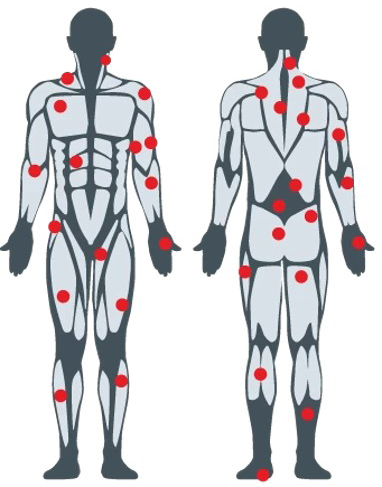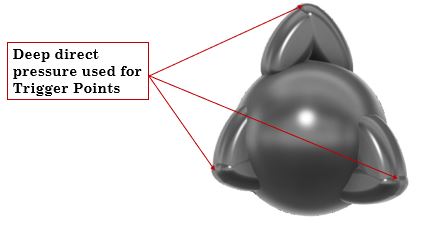
A Trigger Point is a hyper-irritable spot or palpable nodule in the bands of a skeletal muscle’s fascia. Direct compression or muscle contraction can elicit a jump sign, local tenderness, a local twitch response and referred pain which is usually distant from the spot.
The referral patterns of trigger points have been described extensively over the years and correlate heavily in location with the body’s meridian system as described in Eastern Medicine. Research into trigger points is often conflicting and can feel much like going down a rabbit hole.
We don’t necessarily form trigger points for any particular reason. Sometimes sleeping on the cold ground or carrying a heavy backpack is enough. Poor posture, vitamin deficiencies, and repetitive stress activities have also been suggested as culprits. Sometimes there is no apparent reason other than being alive.
What makes a good Trigger Point Tool?
Specificity and control. Trigger points can be notoriously hard to find and don’t always present with the same symptoms. You want a trigger point tool that will fit comfortably in your hand that allows you to sort through various layers of tissue. You also want a trigger point tool that allows for a very precise application of pressure. The Knuckleball™ is exactly that.

The edged tip of each knuckle allows for a very direct, yet precise, application of pressure. The differing heights allow for greater control over depth of penetration. The Knuckleball™ allows you to relax into the treatment rather than focusing on your aching fingers. See the Knuckleball™ being used for Trigger Point Therapy.
How do you treat a Trigger Point?
Similar to the controversy around cause is the controversy around treatment. Non pharmacologic treatment modalities include acupuncture, osteopathic manual medicine techniques, massage, acupressure, ultrasonography, application of heat or ice, diathermy, transcutaneous electrical nerve stimulation, ethyl chloride Spray and Stretch technique, dry needling, and trigger-point injections with local anesthetic, saline, or steroid. The long-term clinical efficacy of various therapies is not clear.
The key to treating trigger points is finding the therapy that is right for you. For many, that involves ischemic compression with a proper trigger point tool such as the Knuckleball™

